Article and photo by Joe Mish
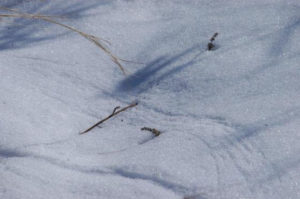
The hand of the wind uses the delicate grass to etch its thoughts in the snow. Nature’s secrets are whispered among the wooded hills and fields for all who pause to ‘listen’.
March is the month when winter puts its house in order to depart our latitude on its tour of the earth.
Remnants of left over winter wind, swept from dark, frozen nooks and crannies, are set free to blow themselves out in the twenty days leading to the arrival of spring.
The force of the wind breathes life into tree canopies and grasses as they dance and sway to the tune of the invisible but palpable energy. There is joy expressed when those, planted in place, unable to change location, experience rhythmic movement in perfect time.
A linear mass of silver maple trees, along the river’s edge, branches tipped with red velvet buds, sway in unison, as they execute a perfect ‘wave’, encouraged on by a burst of wind which leads the cheer.
Consider that the trees and tall meadow grass have evolved to take advantage of the wind. Dispersion of seed that still cling to stems and pods are sent aloft on a later flight to give the best chance for germination than seeds dispersed months earlier.
Trees benefit from the March wind as broken, insect infested branches are excised in a manner to suggest surgical intervention to remove a cancerous limb. The wind effectively prunes tree branches to allow sunlight to penetrate the canopy and promote new leaf growth; each leaf a new solar factory to boost the tree’s nutrient supply.
The wind has a wide range of expression that arises from deep internal turmoil. Perhaps the wind offended the gods in a prideful manner that justified eternal punishment. The gods therefore made the wind invisible to all the senses except for touch, and then only when the wind moves.
The wind constantly struggles with this blow to its vanity and does its best to make its presence known by channeling other elements.
Think about the wind and the scale of expression from hurricanes and tornadoes to a gentle whisper, where the wind uses a dried stem of grass or tree branch to etch its thoughts in the snow or the side of a wood building.
A spring breeze, carrying the scent of lavender blossoms, adds another dimension to the wind’s ‘visibility’ as the wind assumes the identity of the aroma. This is an expanded statement of expression; a loophole to get around the punishment imposed by the gods. This pleases the wind.
As the wind struggles to regain its physical identity and frustration builds, snow and ice are incorporated to flesh out the wind and give it a visible form.
Sometimes the desire to be seen is so fierce, the wind driven snow and ice makes the sense of sight useless, adding to the wind’s frustration, causing it to howl louder and blow harder.
The blustery wind, complement of March’s winter legacy, eventually subsides to become the gentle breeze of spring. The edge of winter passes and tempers the winds attitude to more gentle expressions of mood.
Author Joe Mish has been running wild in New Jersey since childhood when he found ways to escape his mother’s watchful eyes. He continues to trek the swamps, rivers and thickets seeking to share, with the residents and visitors, all of the state’s natural beauty hidden within full view. To read more of his writing and view more of his gorgeous photographs visit Winter Bear Rising, his wordpress blog. Joe’s series “Nature on the Raritan, Hidden in Plain View” runs monthly as part of the LRWP “Voices of the Watershed” series. Writing and photos used with permission from the author.
Photos and Article by Joseph Sapia
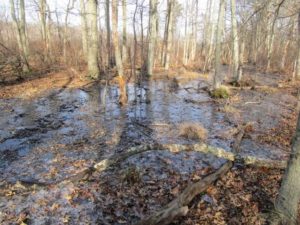
A pond at Szeliga’s Orchard
On this near-to-Christmas day, I was without my Jeep, which was in the shop for most of the day for routine, but time-consuming, maintenance. Without a vehicle, I was living life by foot – walking a mile or so to lunch at the old general store in Helmetta and picking up my mail from my third-generation Post Office box next-door. The walk was to be pragramtic, rather than playful, although I chose a route skirting the woods, instead of walking the Main Road directly from my neighborhood.
After 60 years of living and about 40 years as a journalist, I should know, Be ready for what is out there, unexpected or not. As a woodsman here in the Pine Barrens around Helmetta since old enough, I should know, A walk is not simply a walk.
So, I was glad I put my camera in my pocket.
Before I even left the neighborhood, I came upon a cluster of holly, thick with leaves and holding many berries. A Christmas treat – and my first photographs.
After about three blocks, I went afield, getting on the Pipeline, then onto the freight railroad tracks. Almost immediately on the tracks, I saw a dead mouse lying on a tie between the rails . A victim of a hawk or fox or some other cause of death? I do not know, but another photograph.
As I walked the tracks north, toward Helmetta, I noticed two species of pine: pitch, with its long, swirled needles in clusters of three, along with Virginia, with short, swirling needles in clusters of two. Their green contrasted nicely against the clear, blue sky.
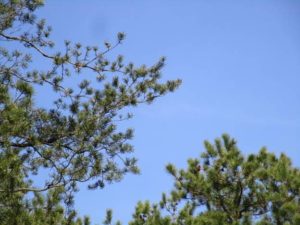
Virginia pine to the left, pitch pine to the right
After crossing Saw Mill Brook, I noticed a third pine in the old Szeliga’s Orchard: white, with supple needles in clusters of five. The species being easy to remember with its five needles, or W-H-I-T-E. It is not a native, here. This was probably an escape from nearby houses.
In the old orchard, I saw ground pine, or Lycopodium. Also, there was a nice little pond – I knew of the swamp, here, but did not remember this much ponding. And there was a fallen tree trunk, pecked by a woodpecker or woodpeckers.
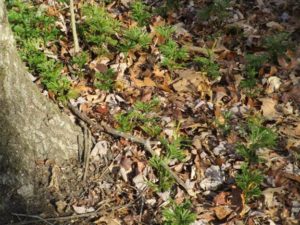
Ground pine at Szeliga’s Orchard
I got to the former worker homes of the George W. Helme Snuff Mill — which ceased production in 1993 and, this year, opened as apartments — and cut through the alley dividing them. After a visit to the Post Office and lunch at the store, I walked to Helmetta Pond.
There, I found a thin layer of ice along the shore – the temperature was now in the low 40s, but overnight it had got down to about 30. Canada geese sat in the pond on its other side by the woods. There, it was a mix of pines on the high ground, swamp hardwoods and Atlantic white cedar in the wetlands – and, it seemed, more and more invasive Phragmites reed grass.
On the way back, I took photos of ice in a ditch and Shekiro’s Pond, which had a cluster of punks, or cat-tails, dying off in the cold weather. Shekiro’s was fending off Phragmites nicely, unlike the Pond to the north and Cranberry Bog to the south.
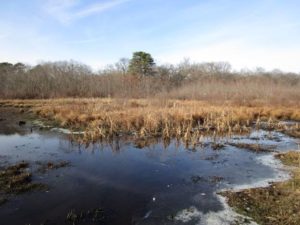
Shekiro’s Pond
At the Bog, I spooked a great blue heron, which took off slowly in flight. But not slowly enough for me to get a photograph. I did stop nearby, though, to shoot a stand of birch on the old Shekiro homestead.
On my way home, I was treated to a ConRail locomotive pulling two hopper cars toward Jamesburg. I snapped photos of the train, glad I had the camera with me over these few hours.
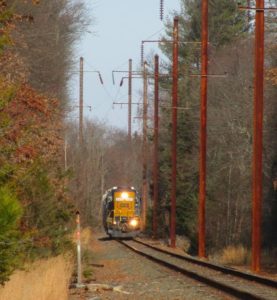
A ConRail train in Helmetta, heading toward Jamesburg
Joe Sapia, 60-years-old, grew up and lives in the Pine Barrens around Helmetta, where his family has resided for more than 100 years. He can be reached at Snufftin@aol.com or at P.O. Box 275, Helmetta, 08828.
Copyright 2016 by Joseph Sapia
Except as noted, article and photos by Joe Mish
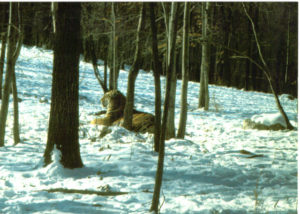
A Siberian tiger, out of place in modern times in New Jersey, comfortably rests on the frozen snow in sub zero temperatures, intensified by a strong northwest wind. Conditions that would turn exposed flesh beet red in an instant, didn’t phase this big cat as it appeared oblivious to the deadly weather; as if not bound by the laws of Nature.
It was a bitter cold day as Bert and I drove the Warner Bros Jungle Habitat trails to check on the open ranging wildlife that occupied the windswept mountains and valleys of the northern New Jersey wildlife park. Inside the warm Chevrolet truck, converted into a veterinary mobile unit, the heater was turned up high, while warm coffee steamed the windshield. Most animals escaped the polar wind hiding behind natural windbreaks and temporary shelters placed around the park.
As we drove past the tiger compound, near the highest point of the park, here was this tiger, a cat we affectionately named, ‘Bobtail’, lying down exposed to the full force of the wind. Bearing an ever present grin, for which the big cats are known, Bobtail appeared content, oblivious to the deadly arctic blast. He remained motionless and stared into the brutal wind that must have escaped from the 10th circle of Dante’s frozen hell, showing no signs of discomfort. He may as well have been enjoying a cool breeze on a warm summer’s day.
This image of Bobtail lying in the snow captures for me the essence of the tiger. Well documented accounts of tigers hunting humans in India, and their magical ability to make kill after kill and avoid inescapable traps, have elevated the tiger to supernatural status.
This is an animal believed to exist in the spirit world as a cunning killer with the ability to transform into flesh and bone and back again at will. The tiger has a reputation of defying natural law that limits all other living things; Bobtail was doing nothing to dispel that myth on this cold day.
The poem, “Tyger”, by William Blake, written in 1794, so well captures the visceral reaction I had to the tigers, I memorized the poem. Here are a few lines that chill my blood.
In what distant deeps or skies Burnt the fire of thine eyes?
And what shoulder, & what art. Could twist the sinews of thy heart?
While here is photographic proof of a tiger living in New Jersey, an anomaly for sure, it is not hard to imagine a time when big cats stalked our land. I wondered every time I passed the tiger compound, how humans ever survived these Paleolithic predators. Perhaps it was the predators’ evolved intelligence that raised the level of human creativity in a Darwinian dance played to a deadly tune.
Evidence of saber tooth cats and jaguars, among other prehistoric creatures, were found in a limestone cave in southeastern PA near Pottstown and trace back to the cretaceous period about 100 to 66 million years ago. The cave was located in a now forgotten town named Port Kennedy, which is part of Valley Forge National Park.
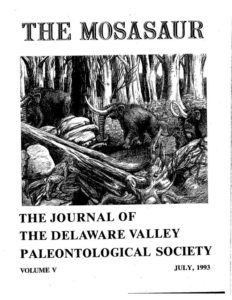
Evidence of sabre-tooth cats of the late cretaceous period discussed in this 1993 article. Additionally fossil remains have been found in the Cutter Clay works near Raritan Bay and along the shore across Raritan Bay in Union Beach.
NJ was unrecognizable in terms of geography and climate with glaciers terminating at the Watchung Mountains and our rivers not yet formed. The Hudson River at one time was thought to have emptied into the lower Raritan watershed at Bound Brook.
As the sea level rose and fell over the eons, it formed clay banks along the Raritan and its bay where dinosaur fossils and tracks have been found. To date, I am not aware of any prehistoric cat trackways or fossils being discovered in NJ. Though surely, when southern NJ was above water, it would be reasonable to expect prehistoric cats, whose remains were found in the Port Kennedy Cave, to have roamed our land.
In more modern times the eastern mountain lion did stalk the shores of the Raritan and in fact a bounty was offered and the last local cat killed in the Sourland Mountains in the early 19th century. Officially, the last New Jersey mountain lions were killed in the southern most counties about that same time.
Rumors of mountain lions persist in several north east states, though no hard evidence has been uncovered in NJ. Given the fact that people have been known to illegally harbor large cats in less than secure enclosures, anything is possible.
Today, New Jersey has a healthy population of bobcats, primarily in the northwest part of the state. The retreating glaciers left a boulder strewn, mountainous landscape with plenty of nooks and crannies, ideal habitat for these elusive felines. Occasionally bobcats are captured on hunters’ trail cameras to give us evidence of their presence as they are rarely ever seen even where they are plentiful.
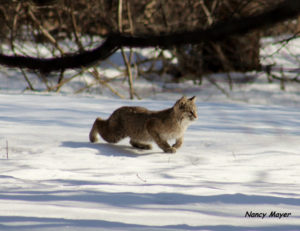
This very rare photo of a bobcat was taken in Warren County, NJ. New Jersey has a healthy bobcat population along with other wildlife thought not to exist within our borders. This cat is really a sabre-tooth tiger distilled down to miniature with all the accumulated intelligence and instincts required for survival in any geologic iteration of New Jersey. Photo by Nancy Mayer
Still the thought of saber-tooth cats, tigers and jaguars ranging across the state becomes more than just imaginary when you see the gleam in your pet cat’s eye. It is as if the prehistoric felines have been distilled down to their essence in the form of modern day cats that dominate many of our homes.
“The Man-Eaters of Kumaon”, by Col Jim Corbett, published in 1944, deals with the man eating tigers of India in the early 20th century. Please read the last chapter, “Just Tigers” before you begin the book as it puts the tiger in perspective and talks about photography vs hunting and concern for their the conservation even at that time. The first hand account of the almost supernatural ability of tigers to avoid being killed or captured while hunting humans, reveals an intellectual battle where man doesn’t always dominate nature.
THE TYGER
By William Blake
Tyger! Tyger! burning bright In the forests of the night, What immortal hand or eye Could frame thy fearful symmetry?
In what distant deeps or skies Burnt the fire of thine eyes? On what wings dare he aspire? What the hand dare sieze the fire?
And what shoulder, & what art. Could twist the sinews of thy heart? And when thy heart began to beat, What dread hand? & what dread feet?
What the hammer? what the chain? In what furnace was thy brain? What the anvil? what dread grasp Dare its deadly terrors clasp?
When the stars threw down their spears, And watered heaven with their tears, Did he smile his work to see? Did he who made the Lamb make thee?
Tyger! Tyger! burning bright In the forests of the night, What immortal hand or eye Dare frame thy fearful symmetry?
1794
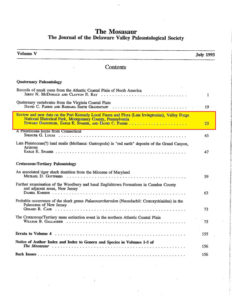
Author Joe Mish has been running wild in New Jersey since childhood when he found ways to escape his mother’s watchful eyes. He continues to trek the swamps, rivers and thickets seeking to share, with the residents and visitors, all of the state’s natural beauty hidden within full view. To read more of his writing and view more of his gorgeous photographs visit Winter Bear Rising, his wordpress blog. Joe’s series “Nature on the Raritan, Hidden in Plain View” runs monthly as part of the LRWP “Voices of the Watershed” series. Writing and photos used with permission from the author.
Article by Dorothy Lee, Rutgers University Sophomore and LRWP Summer Soils Intern
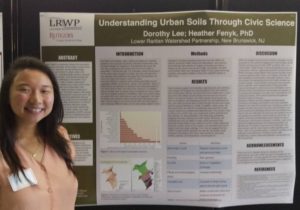
LRWP intern Dorothy Lee, presenting at Rutgers (photo by Heather Fenyk)
This summer I had the opportunity to intern for the LRWP doing soils and civic science research. My job was to conduct initial research into how the LRWP could develop a civic science soil monitoring program to better understand soils functions for an urban watershed level. Urban areas can benefit from soil mapping exercises because urban soils are a concern for food supply, drinking water, stormwater control as well as aesthetics and recreation. Particular issues of urban soils are related to impervious surfaces, erosion, land filling and land leveling, surface removal, contamination, sedimentation and severe compaction. The benefits of working with civic scientists to aid in research means that data can be collected efficiently and in a timely manner while simultaneously connecting the community to their environment.
The LRWP’s specific interests as they relate to soil include soil enrichment for stormwater retention and for bionutrient food availability. After researching these issues, I worked with LRWP President Heather Fenyk and Professor Stephanie Murphy, Director of the Rutgers Soil Testing Lab, to identify ways that the LRWP could begin to engage the Lower Raritan Watershed community in soils research. A few of the actions we thought could orient conversation for future soil-health-oriented civic science studies include: having area civic scientists work to identify “new” bacterial phyla, linking soil health improvement goals to impervious cover remediation actions planned at the municipal level, and evaluating rain gardens as a management strategy to increase soil C, optimize soil N cycling processes, and reduce leaching and gaseous emission losses of nitrogen.
The LRWP is also beginning to develop a plan to communicate the benefits of composting for soil enrichment. This relates directly to my work at Rutgers with a new club, RU Compost. Compost is an efficient way to reduce our food waste, cycle nutrients back into our soils, and create more awareness and education opportunities to the public. At Rutgers our club is working to implement composting in our dining halls and students centers, and we are also working on building a compost demonstration for the Spring semester in the Lower Raritan Watershed. Look for us in the spring!
Photos and article by Michele Bakacs, Environmental and Resource Management Agent, Cooperative Extension of Middlesex County, Rutgers New Jersey Agricultural Experiment Station
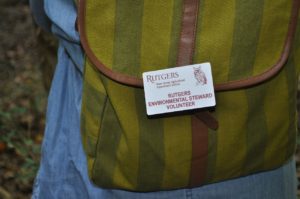
Through a relatively new program sponsored by Rutgers University Cooperative Extension, citizens throughout the Lower Raritan Watershed are working to help people discover the hidden natural world flowing through their communities. These citizens are part of the Rutgers Environmental Steward program and their projects range from conducting stream habitat assessments to developing middle school illustration lessons highlighting the flora and fauna of the watershed.
The goal of the Rutgers Environmental Steward program is to help citizens understand the science behind pressing environmental issues and help create positive environmental change in their communities. Susan Edmunds from Highland Park is one such Environmental Steward working on assessing the health of Mill Brook, a tributary of the Lower Raritan River.
“My goal is to bring an awareness of the Mill Brook to the community so we can work to protect it and use it as an asset. I have realized the most important thing to do is just talk to people about the brook. So many people just don’t know it is there. It would be nice to be able to take a stroll along the brook in some of the already existing parks.”
One morning in September, we scramble down a steep ravine and climb down over branches to the brook. The brook is hidden behind chain link fences, railroad overpasses, and overgrown vegetation. Once you are there you can’t believe how beautiful it is. We are transported to a natural world where the gurgling stream winds its way past towering locusts and silver maple canopy trees, and through sandstone and shale outcrops. Of course we see garbage and dumping typical of every urban waterway- the stereotypical abandoned tire and shopping cart, down trees across the stream collecting trash showing you just how damaging plastic water bottles can be to our environment when not disposed of properly. But except for the occasional train coming by as a reminder, you can barely tell how close we are to houses, roads, and train tracks. There’s the sounds of birds, leaves blowing, shadows and sunlight peaking through the trees on the water. The brook is a hidden gem waiting to be discovered by anyone who makes the effort to find it.
“The Environmental Stewards program was exactly what I hoped it would be in that I gave me a way to start getting involved with environmental protection in my community.”
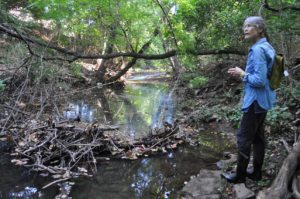
Environmental Steward Susan Edmunds Assesses Mill Brook
Mapping Mill Brook is the project Susan chose for her Rutgers Environmental Steward internship. After attending about 60 hours of classes that start in January and run through June, Stewards complete an internship project of their choosing in order to become a certified Rutgers Environmental Stewards. The program welcomes non-scientists and links them with members of the academic community, government, and non-profits. The curriculum includes classes, field trips, and an internship. Once Susan is done mapping her section of Mill Brook she will summarize her findings for the Lower Raritan Watershed Partnership who will use her work to prioritize sections of the Lower Raritan for monitoring, restoration, and clean up.
“Already this project has connected me with so many people who are just like me in that they want to clean up this stream. From this assessment I plan to create a presentation about the brook and its history. I am excited about the potential for a Friends of the Mill Brook group working together towards stream access. This assessment is just the beginning of my journey.”
During the assessment, Susan takes pictures of deteriorating culverts, tree snags that collect garbage and stormdrain outfalls- concrete pipes that empty the rainwater runoff from local roads into the stream. We walk into a steep ravine probably 25 feet high with sandstone and shale outcrops leading to a large culvert where the stream flows under the NJTransit’s train tracks. This ends today’s journey and we turn around to make our way back to civilization.
If you are like Susan, and looking to start your own journey helping to protect the local environment, then sign up for the 2017 Rutgers Environmental Stewards class. Classes start in January in 5 counties throughout the state including Middlesex County at the EARTH Center in South Brunswick, and Somerset County at Duke Farms. For more information contact Michele Bakacs, at 732-398-5274, mbakacs@rutgers.edu, or visit our website http://envirostewards.rutgers.edu/
The LRWP and Middlesex County Parks are co-hosting a clean-up in Piscataway’s Johnson Park on Saturday January 21.
We will meet at 1030 River Road in Piscataway in the lobby of the County Parks Headquarters Office. There will be signs up to direct folks to the office where there will be a table set up with sign-in forms, trail maps for County open space areas, etc.
Volunteers should dress for the weather, and be prepared to be outdoors. Middlesex County will provide gloves and garbage bags. Parking and bathrooms are on-site.
Everything will have died back off the forest floor at this time of the year so it’s a great time to remove refuse – please let us know if you can make it.
Our October 18 meeting will include a follow-up discussion on Green Infrastructure management with CDM Smith and members of the JerseyWaterWorks Green Infrastructure sub-committee. For background please see the video/audio from our September webinar on the NYC GreenHUB tool, which will frame on-going discussions.
The meeting will be held from 9:30 – 11 am in the Middlesex County Planning Offices at 75 Bayard Street, New Brunswick, NJ – 5th floor mid-size conference room.
Parking is validated for those parking on floors 5 and higher in the RWJ Wellness Parking Deck located at 95 Paterson Street, New Brunswick, NJ 08901. Be sure to bring your ticket to the meeting for validation.
For more information contact Heather: hfenyk AT lowerraritanwatershed DOT org
Meeting Agenda
9:30 Welcome / Introductions
9:35 Recap September Meeting
9:40 Discussion RE: Asset Management for Green Infrastructure in the Lower Raritan Watershed
10:00 Identifying next steps for GI Asset Management in the LRW
10:20 LRWP Project Updates
-Water Quality Monitoring
-Project WADES / Watershed Sculpture Project
-Rail-Arts-River
-Natural Assets Mapping
-Intern / Volunteer Projects
10:50 Upcoming Events
10:55 Partner Announcements
11:00 Adjourn
We have arranged a dial-in number for Jersey Water Works members:
Conference Code: 278926
Host Code: 8789
You are cordially invited to join us for our 3rd annual Watershed Sculpture Project Opening at RWJ Fitness & Wellness Center in New Brunswick Tuesday, December 6, 2015 from 7:000 pm- 9:00pm!
Tickets are $25. Enjoy a meet-and-greet with the artists, light refreshments, and more!
To purchase advance tickets. All proceeds benefit the Watershed Sculpture Project.
2016 Watershed Sculpture Project Themes
In Spring 2016 the LRWP and coLAB Arts worked with Sarah Grunstein’s Highland Park High School sculpture class, using interdisciplinary strategies to match in school art and science curricula with Next Generation Science Standards for innovative project based learning. At our gallery opening we will showcase student work.
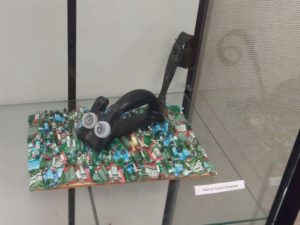 HPHS Student work created from trash gathered during stream clean-ups
HPHS Student work created from trash gathered during stream clean-ups
Also on display will be new commissioned pieces that incorporate the theme of “frames” into sculptures that frame the landscape and can be installed semi permanently along the Raritan River Waterfront at Boyd Park in New Brunswick, and photograph prints from the Raritan River Basin series by No Water No Life‘s Alison M. Jones.
We will discuss the Watershed Sculpture Project in the context of Environmental Health and Community Wellness, focusing on how public art installations along the Raritan River might prompt visitors to interact in more positive ways with New Jersey’s largest major waterway.
About the Watershed Sculpture Project
The Watershed Sculpture Project is the result of a partnership between coLAB Arts and the LRWP. Our organizations seek to create awareness of the maturing visual arts scene in the Lower Raritan Watershed as well as the need for community involvement to restore its health. coLAB Arts and LRWP coordinate volunteer clean-ups of area streams and from the refuse collected we identify objects to give to commissioned artists who then create original sculptures for public display.
With thanks to Johnson & Johnson, the Highland Park Educational Foundation and Robert Wood Johnson Wellness & Fitness Center for their support for this project.
The Original Raritan River Festival was started by Pete Seeger and his fellow environmentalists 35 years ago – this annual event is a full day of family oriented events.
Please plan to join the LRWP and friends on Sunday September 25, 2016 from noon-6 pm in New Brunswick’s Boyd Park for this year’s Raritan River Festival!
Three stages will be running throughout the day, with other activities including the rubber duck race, cardboard canoe race , environmental activities and more. Food, vendors and beer garden on the grounds.
The LRWP and coLAB Arts will showcase sculptures created as part of the third annual “Watershed Sculpture Project.” Activities include hands-on art projects, milkweed seed pod preparation for pollinator gardens and more!
Free Admission!
GPS Coordinates: N 40° 29′ 39.9192″, W 74° 26′ 15.9534″
Driving Directions:
From Route 1 :
• Take Route 18 North
• Pass through the first light at Paulus Boulevard
• STAY TO THE RIGHT after this light Follow signs towards New Brunswick Exits/Route 27
• Continue through two (2) traffic lights (DO NOT TURN AT THE SIGN FOR BOYD PARK)
• Pass under New Street
• Make the first right into the New Brunswick Landing – ENTRANCE IS BEFORE THE EXIT FOR ROUTE 27 NORTH/HIGHLAND PARK
From New Jersey Turnpike:
• Take the NJ Turnpike to Exit 9 (New Brunswick)
• Follow directions for Route 1
Join the Lower Raritan Watershed Partnership and COLAB ARTS for our 3rd annual Sculpture Project Clean-Up!
WHAT: LRWP and Colab Arts are teaming up Sunday the 11th from 10AM to 1PM to prepare for our 3rd Annual Sculpture project. In order to do so, we need your help to remove trash from streams and tributaries of the Raritan River. This is no ordinary clean-up! Items found will be given to local artists to be made into sculptures that will be displayed in New Brunswick.
WHERE: We will meet at 10AM at 16 Woodbridge Street, New Brunswick and from there head to Mile Run for the clean-up.
Gloves, trash bags and other supplies will be provided.
Contact Heather for more information: hfenyk AT lowerraritanwatershed DOT org














